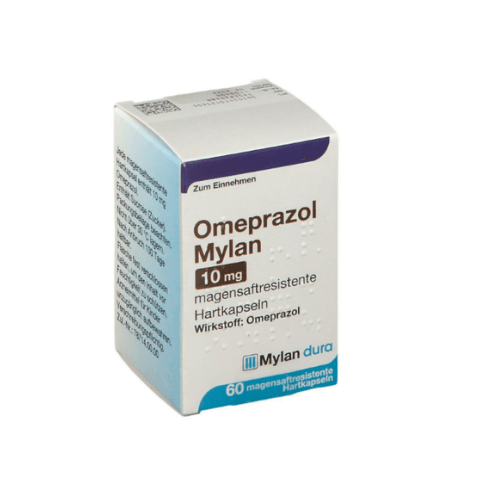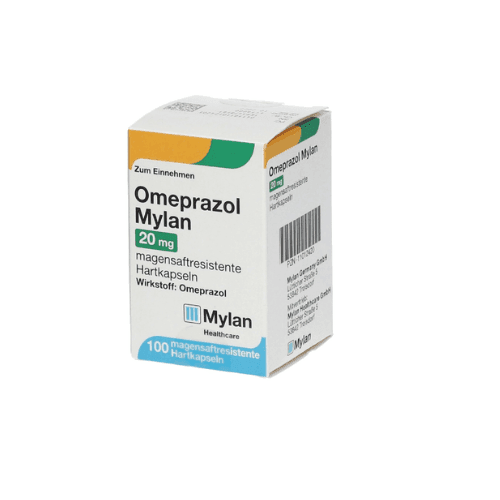Shipping with this method takes 3-5 days
Prilosec® Capsules for GERD
Price range: $42.99 through $107.99
Secure Encrypted Payments
Omeprazole is a proton pump inhibitor used for acid-related conditions. This page explains how it works, dosing basics, safety, and ordering options with US delivery from Canada. It also outlines ways to pay without insurance.
YouDrugstore is a licensed Canadian pharmacy in Manitoba. Pharmacists review prescriptions before dispensing.
What Omeprazole Is and How It Works
Omeprazole reduces stomach acid by blocking the gastric proton pump (H+/K+-ATPase). It is the active ingredient in Prilosec®. By lowering acid, the treatment can help relieve heartburn, support healing of erosive esophagitis, and reduce ulcer risk in specific situations. Effects build with consistent daily use. It is not intended for immediate symptom relief.
This medicine belongs to the PPI class. PPIs suppress acid production at the final step of secretion. Taking it before meals helps the therapy reach pumps that activate during eating. For broader context on digestion-related therapies, see our Gastrointestinal category. For a related PPI overview, read Dexilant Dexlansoprazole Uses.
Who It’s For
Indications include gastroesophageal reflux disease (GERD) and healing of erosive esophagitis. It is also used for duodenal ulcer and gastric ulcer therapy, and as part of triple therapy for H. pylori when prescribed with antibiotics. In rare acid hypersecretion states such as Zollinger–Ellison syndrome, clinicians may use higher-intensity regimens.
Explore related conditions: Gastroesophageal Reflux Disease, Peptic Ulcer Disease, and Zollinger Ellison Syndrome.
Do not use if there is a known allergy to omeprazole or other PPIs. People with severe liver impairment, low magnesium, or osteoporosis risk should discuss monitoring. It is not for immediate relief of acute heartburn pain.
Dosage and Usage
Follow the directions on the prescribed label. Typically, the therapy is taken once daily before a meal. Some conditions may require a longer course or a different schedule as directed by a healthcare professional. Swallow delayed‑release capsules or tablets whole. Do not crush or chew the enteric coating. For patients who receive granules or suspension, mix and take exactly as instructed on the product label.
Consistent timing supports steady acid control. Avoid taking with food unless the label indicates otherwise. If antacids are also used, separate administration according to your prescriber’s advice. For H. pylori regimens, the medicine is taken with antibiotics; follow the full course as prescribed.
Strengths and Forms
Common presentations include delayed‑release capsules and delayed‑release tablets. Published strengths often include 10 mg, 20 mg, and 40 mg. Availability can vary by manufacturer and market. Some products are over‑the‑counter, while others require a prescription. Your order will reflect the item listed on the product page when in stock.
Many patients use omeprazole delayed release tablets 20 mg when directed by their prescriber. Always verify the strength on your pharmacy label.
Missed Dose and Timing
If a dose is missed, take it when remembered unless it is close to the next scheduled dose. If the next dose is near, skip the missed dose. Do not double up. Keeping a daily reminder can help maintain a regular schedule and steady acid suppression.
Storage and Travel Basics
Store the product at room temperature, in a dry place, and away from excess moisture. Keep it in the original container with the label intact. Protect from light as advised on the packaging. Place it out of reach of children and pets. Do not use tablets or capsules that are damaged or past the expiry date.
For travel, pack the medicine in a carry‑on bag with the original labeled container. Bring a copy of the prescription or a medication list. Use a small pill organizer only if labels are also carried for security checks. Avoid heat and humidity, such as a parked car on a hot day. If crossing borders, allow extra time for screening of medications.
Benefits
This therapy decreases stomach acid, which may ease heartburn and support healing of inflamed tissue in the esophagus. It can help prevent symptom flare‑ups when taken as directed. Once‑daily schedules are common and convenient for many conditions. The class is also used to reduce ulcer risk during certain antibiotic regimens for H. pylori.
Side Effects and Safety
- Headache
- Abdominal pain
- Nausea or vomiting
- Diarrhea or constipation
- Gas and bloating
- Dizziness
Serious effects are uncommon but can include severe allergic reactions, kidney issues, low magnesium, B12 deficiency with long‑term use, C. difficile–associated diarrhea, or bone effects with prolonged high‑dose therapy. Seek urgent care for signs of anaphylaxis, severe rash, chest pain, black stools, or persistent vomiting. Those using insulin or sulfonylureas should monitor as directed by their clinician when significant vomiting or reduced intake occurs.
Drug Interactions and Cautions
Potential interactions include clopidogrel, warfarin, methotrexate, digoxin, tacrolimus, and some antifungals and antivirals. Strong inducers or inhibitors of CYP2C19 and CYP3A4 may change levels. Products that require acidic pH for absorption can be affected. Tell your healthcare professional about all medicines, vitamins, and herbal products, including St. John’s wort.
Use caution with severe liver impairment. Discuss risks and benefits during pregnancy or breastfeeding. Long‑term continuous PPI therapy should be reviewed periodically to confirm ongoing need.
What to Expect Over Time
Symptom relief typically improves with consistent daily use. Heartburn and regurgitation may ease after several doses, while healing of inflamed tissue can require longer under medical supervision. This medicine does not work instantly; rescue antacids may still be used as directed for occasional breakthrough discomfort. If symptoms persist or worsen, consult the prescriber for evaluation.
Compare With Alternatives
Other PPIs may be considered if response or tolerability differs. Options include Esomeprazole and Pantoprazole. These medicines work through the same pump‑blocking mechanism but have different dosing and labeling. Choice often depends on clinical history, interactions, and prescriber preference.
Pricing and Access
Canadian pharmacy pricing can offer value for eligible patients. This product Ships from Canada to US, subject to valid prescription requirements. Check current availability and omeprazole 20 mg cash price on the product page. For occasional coupons and seasonal offers, visit our Promotions page. Checkout is encrypted to protect personal information.
To explore related options and categories, browse our Gastrointestinal section for similar therapies and supportive products.
Availability and Substitutions
Supply can vary by strength, manufacturer, and form. If the requested item is not available, a prescriber may recommend an alternative PPI or a different strength suited to the treatment plan. We do not provide medical advice; discuss any substitutions with the prescribing clinician before making changes.
Patient Suitability and Cost-Saving Tips
Good candidates are adults diagnosed with GERD, erosive esophagitis, peptic ulcer disease, or those undergoing H. pylori eradication as directed. Avoid use with a known PPI allergy. People with kidney problems, low magnesium, severe liver disease, or frequent infections should review risks carefully with a healthcare professional.
To help manage costs and adherence, consider multi‑month fills if appropriate, and set reminder alerts for on‑time refills. Keeping medicine in a visible but child‑safe location supports daily routines. For travel, carry enough supply and the labeled container in your hand luggage.
Questions to Ask Your Clinician
- What condition is this PPI treating in my case?
- How long should therapy continue before reassessment?
- Are antacids or H2 blockers appropriate for breakthrough symptoms?
- Which potential interactions matter most with my current medications?
- What monitoring is recommended for long‑term use?
- How should dosing change, if at all, for H. pylori therapy?
- What signs or symptoms mean I should stop and seek care?
Authoritative Sources
Official information is available from these sources: FDA DailyMed Omeprazole; Health Canada DPD Omeprazole; AstraZeneca Prilosec Prescribing Info.
Ready to proceed? Place your order with US shipping from Canada, and expect temperature-controlled handling when required. This information is educational and not a substitute for professional medical advice.
Express Shipping - from $25.00
Prices:
- Dry-Packed Products $25.00
- Cold-Packed Products $35.00
Shipping Countries:
- United States (all contiguous states**)
- Worldwide (excludes some countries***)
Standard Shipping - $15.00
Shipping with this method takes 5-10 days
Prices:
- Dry-Packed Products $15.00
- Not available for Cold-Packed products
Shipping Countries:
- United States (all contiguous states**)
- Worldwide (excludes some countries***)
How long before meals should omeprazole be taken?
Labels typically recommend taking a dose before a meal, often in the morning. Administering it before eating helps the drug reach active proton pumps. Consistent timing supports more steady acid control. Follow the exact timing on the product label or as directed by a healthcare professional, since instructions can differ by form, indication, and dose strength.
Can antacids be used with omeprazole?
Short‑acting antacids are sometimes used for breakthrough heartburn while on a PPI. They work differently and can provide quick relief of occasional symptoms. Space administration from other medicines as advised to avoid absorption issues. Check the label or consult a healthcare professional to confirm compatibility with current therapies and to ensure proper timing.
Is omeprazole safe for long‑term use?
For many patients, PPIs are used beyond initial healing phases when benefits outweigh risks. Long‑term use may be associated with low magnesium, B12 deficiency, bone effects, infections, or kidney concerns. Periodic review with a clinician helps confirm ongoing need and monitoring. The lowest effective dose for the shortest necessary duration is commonly recommended in guidelines.
What if swallowing capsules is difficult?
Some delayed‑release products offer granules or a suspension option. Certain capsules may be opened and the pellets sprinkled on soft food if the specific label allows. Do not crush or chew enteric‑coated pellets. Always follow the instructions for the exact product dispensed. If uncertainty remains, ask a pharmacist to review the safest method for administration.
Can omeprazole be used in H. pylori therapy?
Yes, it is commonly included in triple therapy with antibiotics for H. pylori eradication. The specific combination and duration are determined by local guidelines and clinician preference. Completing the full course is important. If side effects occur during therapy, contact a healthcare professional to discuss management and whether regimen adjustments are needed.
What are signs of a serious reaction?
Seek urgent care for symptoms of anaphylaxis such as hives, swelling of the face or throat, wheezing, or severe dizziness. Other concerning signs include sharp chest pain, black or bloody stools, persistent vomiting, severe abdominal pain, or significant new kidney‑related symptoms like reduced urine output. Serious reactions are uncommon but require immediate medical attention.
Are OTC and prescription products different?
Over‑the‑counter options are typically labeled for short courses in frequent heartburn, while prescription versions cover additional indications and regimens. The active ingredient may be the same, but strengths, duration, and instructions can differ. Always follow the label that comes with the specific product dispensed and consult a pharmacist or clinician with any questions.

